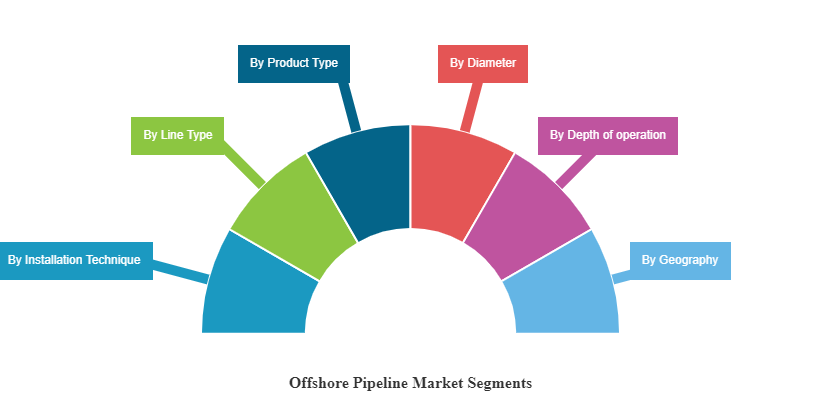Home / Energy & Power / Offshore Pipeline Market
Offshore Pipeline Market Size, Share and Global Trend By Installation Technique (S lay, J lay, Tow In), By Line Type (Transport Line, Export Line), By Product Type (Natural Gas, Crude Oil, Refined Products), By Diameter (Below 24 Inch, Above 24 inch), By Depth of Operation (Shallow Water, Deep Water) and By Regional Forecast, 2025-2032
Report Format: PDF | Published Date: Ongoing | Report ID: FBI100408 | Status : UpcomingTransportation of the extracted hydrocarbons to the destined location should be carried out without any spills and should be economical. Offshore pipelines are the best solution for the transportation of hydrocarbons from one place to another. Offshore pipelines are preferred over ships as the risks of spillage is less and offshore pipeline is unaffected by tides, cyclones, etc.
It also acts as the best, safe, and most economical way of transportation. The pipelines laid once can be used for years thereafter. Laying offshore pipelines also omits the problem faced for the storage of extracted deposits. Study of pipeline length, type of sea bed, obstacles that could be faced after installation, etc. have to be done before the pipeline is laid in order to reduce potential hazard, operation & maintenance cost.
On the basis of the Installation techniques, offshore pipelines can be segmented into S lay, J lay, and Tow In. In S lay technique, the pipe curves two times which gives it a S-shape before being laid down on the sea bed. The J lay installation puts less stress on pipe by only a single curve at the touchdown point on the sea bed. On the basis of the line type, offshore pipeline can be segmented into export line, transport line, and others. Transportation lines are suitable for long-distance and its large diameter pipes used for moving products between countries, and continents.

On the basis of product, offshore pipeline market can be segmented into natural gas, crude oil, and refined products. On the basis of diameter, offshore pipelines can be segmented into below 24 inches and above 24-inch pipe. Depending upon the diameter of the pipe, the pressure and flow of hydrocarbons is controlled. On the basis of the water depth, the market can be segmented into shallow water and deep water. In shallow water, Tow-In technique is preferred because of the advantage of assembling pipe onshore and the use of small vessels for carrying pipe strings to installation sites. In Deep water, S-lay and J-lay techniques are widely used as they provide high pipe laying rate with wide range of pipeline diameter.
The major market driver for the global offshore pipeline market is the increasing demand of crude oil, natural gas and refined products by the high energy consuming countries. As transportation through pipelines is efficient as compared to other means of transport, the market for offshore pipelines will rise to fulfil the increasing demands.
High initial cost of installation of the offshore pipeline and the difficulties faced in inspection and maintenance of the installed offshore pipelines acts as a key market restraint for the global offshore pipeline market.
Key Players Covered
Some of the notable companies in the offshore pipelines are Technip, Saipem, Subsea 7, Petrofac, Allseas, National petroleum construction company, Mc Dermott international, Penspen, Senaat, Tmk Group, United states steel corporation, Jesco, Sapura, Wood group, Furgo, Atteris, and Tenaric.
Segmentation
ATTRIBUTE |
DETAILS |
By Installation Technique |
|
By Line Type |
|
By Product Type |
|
By Diameter |
|
By Depth of Operation |
|
By Geography |
|
Regional Analysis
The global offshore market has been segmented into North America, Europe, Asia Pacific, Latin America, and Middle East and Africa. USA has the maximum length of offshore pipelines for oil and gas installed in the world. Europe also has a good established network of offshore pipelines with Russia, United Kingdom, Germany is at the top in terms of length of pipeline installed. Brazil has a good offshore pipeline network in the Latin America. Southeast Asia has a huge potential for offshore pipeline network with hydrocarbon rich countries in the southeast. In Asia pacific the growing demand for natural gas and refined products is mainly coming from countries like China and India. The growing demand has opened the gates for immense potential in offshore oil and gas pipelines.
Key Industry Developments
- In February 2019, McDermott International announced two sizeable contracts, one from Sarawak Shell Berhad and one from Sapura Exploration and Production to provide transportation and installation for offshore structures and pipelines for Malaysian offshore projects.
- In February 2019, Liberty pipe mills at hartlepool has been awarded a multimillion-dollar contract to supply steel pipeline for North Sea Gas.
- In April 2019, Subsea 7 Announced about the oil production dock manifolds and subsea pipelines contract, offshore Saudi Arabia. The contract was given by Saudi Aramco for conventional projects in shallow water.
- Global
- 2023
- 2019-2022


